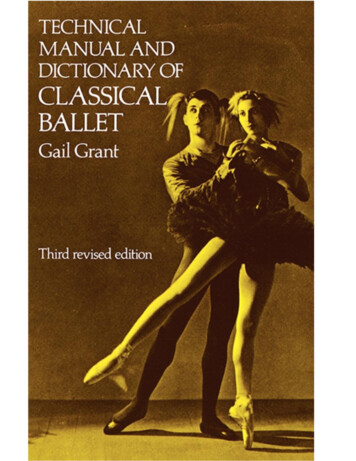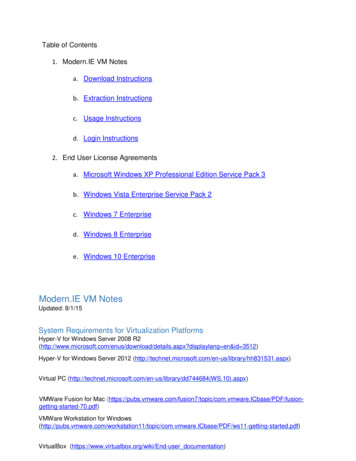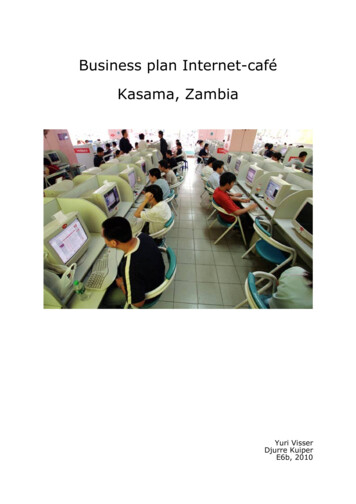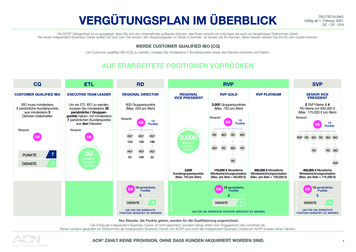
Transcription
1
Technical Manual andDictionary ofClassical BalletThird Revised EditionGail GrantILLUSTRATED BY THE AUTHORDover Publications, Inc.NEW YORK2
Copyright 1967, 1982 by Dover Publications, Inc.All rights reserved.This third edition, first published by Dover Publications, Inc., in 1982, is anew thorough revision starting out from the second edition, first published byDover in 1967. That 1967 version was itself a thoroughly revised republication,with regard to both text and illustrations, of the work first published by KaminDance Publishers, New York, in 1950. The Prefaces to the Second and ThirdEditions, the Pronunciation Guide and the Bibliography are completely newfeatures of the Dover editions.International Standard Book NumberISBN-13: 978-0-486-21843-4ISBN-10: 0-486-21843-0Library of Congress Catalog Card Number: 67-26481Manufactured in the United States by Courier Corporation21843040www.doverpublications.com3
TO W. J. R.4
Preface to the Third EditionThis new 1982 Dover edition of Gail Grant’s Technical Manual andDictionary of Classical Ballet has been completely revised, and over 300 newterms have been added, all of them alphabetized into the text.Four new books have been added to the bibliography as sources for therevisions and the additional terms.WALTER J. RYANBoca Raton, Florida5
Preface to the Second EditionThe first edition of Gail Grant’s Technical Manual and Dictionary ofClassical Ballet was published in 1950. This new and revised 1967 Doveredition has so considerably broadened the scope of her original work that itshould find even readier acceptance by students, teachers, choreographers,dance directors and balletomanes.Augmenting Miss Grant’s initial effort are these new and valuableadjuncts:1. Nearly 100 additional terms have been incorporated.2. All terms are now in one complete alphabetical listing, including all thenewly added terms and those formerly added in an appendix.3. Each foreign-language term is followed by an improved phonetic aid topronunciation which will be immediately useful even to those readers whomay know little or nothing of the French and Italian languages. The generalguide to this phonetic aid is to be found on page xiii.4. New and revised illustrations have been added. All illustrations are nowlocated in one section of the book for ease of reference.5. A bibliography has been added.6. There are three distinct schools of ballet technique—the classic Italian(Cecchetti method), the graceful French and the strong Russian. Thefundamental principles of classical technique are the same in all three.However, certain steps, exercises, poses and movements are performed indifferent ways and different names are given to similar steps and positions bythese three schools. This edition has completely cross-referenced thesedissimilarities and the resultant terminological deviations. The newtypographic arrangement makes for effortless reading and quick references.By vastly improving her original text and format, Miss Grant hasfashioned a manual and dictionary that has every opportunity for acceptanceas the official textbook of classical ballet for all dance associations andinstitutions.WALTER J. RYANToledo, OhioJanuary 19676
ContentsPreface to the Third EditionPreface to the Second EditionList of IllustrationsPronunciation ns7
List of IllustrationsDiagrammatic Floor Plan: Directions of Body and FeetArabesques: Cecchetti MethodArabesques: French SchoolArabesques: Russian SchoolAttitudesPositions des Bras: Cecchetti MethodPositions des Bras: French SchoolPositions des Bras: Russian SchoolBasic Positions of the Body: Cecchetti MethodBasic Positions of the Body: Russian and French SchoolsFixed Points of the Practice Room or Stage: Cecchetti MethodFixed Points of the Practice Room or Stage: Russian School (Vaganova)Cinq Positions des Pieds8
Pronunciation GuideSince most of the terms used in classical ballet are French (a few areItalian), we have provided a phonetic aid to pronunciation immediatelyfollowing each foreign-language key word. Naturally, these simplifiedpronunciations are only approximate, but you will not go far wrong if youremember the following rules of thumb:LETTER(S)AS INSHOULD BE PRONOUNCEDaba-law-NAYExcept when shown in the combinations “ah,” “ahn,” “aw,” “awn” and “ay”(the next five items on this list), the “a” in the phonetic aids should always bepronounced like the a in cat, never like any other kind of a.ahrwah-YALAs in English, but not drawn out.ahntahnLike ah in English, but pronounced very strongly “through the nose.”awvaw-LAYLike the aw in tawdry, but not drawn out.awnrawnLike the aw in tawdry, but pronounced very strongly “through the nose.”ayra-ma-SAYLike ay in play, but not drawn out.e, ehpeer-WET; eh-fa-SAYLike the e in met.eeweetAs in English.enpwentLike the a in cat, but pronounced very strongly “through the nose.”ewba-TEWTo make this sound, round your lips as if to say oo, then (without movingyour lips!) say ee.9
ggrahnLike the g in good.ohsoh-TAYAs in English, but not drawn out.oooo-VEHRLike the oo in food, but not drawn out.rfehr-MAYMay be rolled with the tip of the tongue. The Parisian r, made at the backof the mouth, resembles the sound of gargling.s, ssseessLike the s in sit.uhpuh-TEELike the e in battery, this is a weak, vague sound. Any syllable in which itappears is generally pronounced very quickly, so that puh-TEE is practicallylike p-tee.uhduh-ZYEMTo make this sound, round your lips as if to say oh, then (without movingyour lips!) say eh.uhnuhnThis is the same as the preceding sound (uh) but pronounced very strongly“through the nose.”zhzhahnbLike the z in azure.All other sounds are as in English.Syllables printed in capital letters receive more stress (although stress inFrench words is generally not as strong as in most English words).The phonetic pronunciation is always given in the normal word order. Forinstance, the phonetic pronunciation for the key word “Battement, grand” isgiven as if for “Grand battement”: grahn bat-MAHN.10
BibliographyAlbertieri, Luigi. The Art of Terpsichore. New York, 1923.Beaumont, Cyril W. Dictionary of Technical Terms Used in ClassicalBallet. London, 1939.——. A Primer of Classical Ballet. London, 1941.——. The Theory and Practice of Classical Theatrical Dancing. London,1940.Bourgat, Marcelle. Technique de la Danse. Paris, 1946.Bruhn, Eric, and Moore, Lillian. Bournonville and BalletTechnique. London, 1961.Craske, Margaret, and Beaumont, Cyril W. The Theory and Practice ofAllegro in Classical Ballet (Cecchetti Method). London, 1930.——. The Theory and Practice of Advanced Allegro in Classical Ballet(Cecchetti Method). London, 1956.Espinosa, Eduard. Technical Dictionary of Dancing. London, 1935.French, Ruth, and Demery, Felix. Advanced Steps in Ballet.London, 1950.——. First Steps in Ballet. London, 1934.——. Intermediate Steps. London, 1947.Guillot, Genevieve, and Prudhommeau, Germaine. The Book ofBallet. Englewood Cliffs, N.J., 1976.Kersley, Leo, and Sinclair, Janet. A Dictionary of Ballet Terms.London,1952.Kirstein, Lincoln, and Stuart, Muriel. The Classic Ballet. New York, 1952.Kostrovitskaya, Vera, and Pisarev, A. School of Classical Dance.Moscow,1978.Lawson, Joan. Classical Ballet, Its Style and Technique. London, 1960.Legat, Nadine Nicolaeva-. Ballet Education. London, 1947.——. Preparation for Ballet. London, 1953.Lifar, Serge. Lifar on Classical Ballet. London, 1951.Mara, Thalia. The Language of Ballet. Cleveland, 1966.Messerer, Asaf. Classes in Classical Ballet. New York, 1975.Meunier, Antonine. La Danse classique. Paris, 1931.Noverre, Jean-Georges. Lettres sur la danse, et sur les ballets.Lyons,1760.Vaganova, Agrippina. Fundamentals of the Classic Dance. New York,1946. (Reprinted by Dover, with additions and corrections, asBasic Principlesof Classical Ballet.)Wilson, G. B. L. A Dictionary of Ballet. London, 1957.11
Technical Manual andDictionary ofClassical Ballet12
Technical Manual and Dictionary of Classical BalletAbstract ballet. A ballet without a plot. A composition of pure dancemovement expressed for its own sake.Adage, Adagio [French: a-DAHZH]. Adage is a French word derivedfrom the Italian ad agio, meaning at ease or leisure. English ballet teachersuse “adage,” the French adaptation, while Americans prefer the originalItalian. In dancing it has two meanings: (1) A series of exercises following thecentre practice, consisting of a succession of slow and graceful movementswhich may be simple or of the most complex character, performed withfluidity and apparent ease. These exercises develop a sustaining power, senseof line, balance and the beautiful poise which enables the dancer to performwith majesty and grace. The principal steps of adagio are pliés, développés,grand fouetté en tournant, dégagés, grand rond de jambe, rond de jambe enl’air, coupés, battements tendus, attitudes, arabesques, preparations forpirouettes and all types of pirouettes. (2) The opening section of the classicalpas de deux, in which the ballerina, assisted by her male partner, performs theslow movements and enlèvements in which the danseur lifts, supports orcarries the danseuse. The danseuse thus supported exhibits her grace, line andperfect balance while executing développés, pirouettes, arabesques and so on,and achieves combinations of steps and poses which would be impossiblewithout the aid of her partner.Ailes de pigeon [el duh pee-ZHAWN]. Pigeon’s wings. The dancerperforms a cabriole devant, then the legs change and beat again, then changeonce more before the dancer lands on the leg he or she jumped from, leavingthe other leg extended in the air. Also known as “pistolet.”Air, en l’ [ahn lehr]. In the air. Indicates: (1) that a movement is to bemade in the air; for example, rond de jambe en l’air; (2) that the working leg,after being opened to the second or fourth position à terre, is to be raised to ahorizontal position with the toe on the level of the hip.Alignment. See Directions or body alignment.Allégro [a-lay-GROH; Italian: al-LAY-groh]. Brisk, lively. A termapplied to all bright and brisk movements. All steps of elevation such as theentrechat, cabriole, assemblé, jeté and so on, come under this classification.The majority of dances, both solo and group, are built on allégro. The mostimportant qualities to aim at in allégro are lightness, smoothness and ballon.Allongé, allongée [a-lawn-ZHAY]. Extended, outstretched. As, forexample, in arabesque allongée.Angle of the leg in the air. In the Russian School the angle formed bythe legs in relation to the vertical axis of the body is measured in generalterms. For example, 45 degrees for half height (demi-hauteur), 90 degrees fora horizontal position with the toe at hip height (à la hauteur) and 135 degreesfor any position considerably above hip height. See Positions soulevées.13
Aplomb [a-PLAWN]. Assurance, poise. This term applied to the dancermeans that he or she has full control of body and limbs with the weightcorrectly centered during a movement.Arabesque [a-ra-BESK]. One of the basic poses in ballet, arabesquetakes its name from a form of Moorish ornament. In ballet it is a position ofthe body, in profile, supported on one leg, which can be straight or demi-plié,with the other leg extended behind and at right angles to it, and the arms heldin various harmonious positions creating the longest possible line from thefingertips to the toes. The shoulders must be held square to the line ofdirection. The forms of arabesque are varied to infinity. The Cecchetti methoduses five principal arabesques; the Russian School (Vaganova), four; and theFrench School, two. Arabesques are generally used to conclude a phrase ofsteps, both in the slow movements of adagio and the brisk, gay movements ofallégro.THE CECCHETTI ARABESQUES (See illustrations, p. 126)First arabesque: The body is held upright from the waist and is supportedon a straight leg with the other leg extended and at right angles to thesupporting leg. The shoulders are held square to the line of direction with thearms extended, palms down, so that the extended fingertips of the forwardarm (which is the one on the same side as the supporting leg) are in a line withthe centre of the space between the eyes, and the extended back arm slightlylowered so that the arms are in one straight line. The forward hand should beslightly turned outward.Second arabesque: The arms are reversed so that the forward arm is theopposite to the supporting leg. The head is slightly inclined and turned towardthe audience.Third arabesque: Both arms are extended forward to the side of thesupporting leg. The fingertips of the arm farther from the audience are in aline with the centre of the space between the eyes while the arm nearer theaudience is in a line with the shoulder.Fourth arabesque: The supporting leg is nearer the audience and is indemi-plié. The arms and head are held as in the first arabesque with the armon the side of the raised leg being forward.Fifth arabesque: The arms and head are held as in the third arabesquewith the arm farther from the audience being the higher. The supporting leg isthe leg nearer the audience and is in demi-plié.The fourth and fifth arabesques are usually taken facing the right frontcorner of the room or stage if the supporting leg is the left, or facing the leftfront corner if the supporting leg is the right. In the illustrations the position isshown sideways for the sake of clearness.THE FRENCH ARABESQUES (See illustrations, p. 127)14
Arabesque ouverte: The body is supported on a straight leg with the otherextended and at right angles to the supporting leg, the extended leg beingnearer the audience. The body leans forward with the arm on the side of thesupporting leg held in front and the other taken well back and held parallel tothe extended leg.Arabesque croisée: The position is the same as the above but thesupporting leg is the leg nearer to the audience, the arm on the side of thesupporting leg held forward.THE RUSSIAN ARABESQUES (VAGANOVA) (See illustrations, p. 128)First arabesque: The body is supported on one leg with the other lifted ata right or greater angle to the supporting leg. The body is inclined forwardfrom the waist with a strongly arched back. The arm on the side of thesupporting leg is extended forward and the other taken out to the side a littlebehind the second position.Second arabesque: The body and legs are the same as in the firstarabesque but the arms are reversed. That is, the arm on the side of thesupporting leg is taken back far enough to be seen behind the body while theother arm is extended forward. The head is turned toward the audience.Third arabesque: This arabesque faces diagonally toward the audience.The supporting leg is nearer the audience with the other raised in croiséderrière at right angles to the supporting leg. The body is inclined forwardwith the arm opposite the supporting leg extended forward on a level with theshoulder and the other arm extended to the side. The head is turned towardthe forward arm.Fourth arabesque: The legs are in the same position as in the thirdarabesque but the arms are reversed and held at shoulder level. The arm onthe side of the supporting leg is brought forward and the other arm taken backfar enough to be seen behind the back. The body is half turned away from theaudience by the strong arching of the back, with the head turned toward theaudience.Arabesque, en [ah na-ra-BESK]. In arabesque, that is, in an arabesqueposition. As, for example, in pirouette en arabesque.Arabesque à deux bras [a-ra-BESK a duh brah]. Arabesque with twoarms. This arabesque is taken in profile with the extended leg nearest theaudience. Both arms are extended forward with the arm on the side of thesupporting leg held slightly higher. The head may be held in profile or turnedto the audience.Arabesque à la demi-hauteur [a-ra-BESK a lah duh-MEE-oh-TUHR].Arabesque at half-height. A term of the French School. In this arabesque thefoot is raised to a position halfway between the position à terre and ahorizontal position in the air.15
Arabesque à la hauteur [a-ra-BESK a lah oh-TUHR]. Arabesque at theheight. A term of the French School. An arabesque in which the working leg israised at right angles to the hip. Also termed arabesque allongée.Arabesque à la lyre [a-ra-BESK a lah leer]. Arabesque with the lyre.This position resembles the arabesque à deux bras (third arabesque Cecchetti)but both palms are held up and the elbows are slightly curved as if the dancerwere holding a lyre.Arabesque allongée [a-ra-BESK a-lawn-ZHAY]. Extended oroutstretched arabesque. The line required for this arabesque is a horizontalone. See Arabesque à la hauteur.Arabesque allongée à terre [a-ra-BESK a-lawn-ZHAY a tehr].Arabesque extended on the ground. In this arabesque the body is supportedon one leg which is completely bent in plié while the other leg is extended inthe back with the foot well turned out and on the ground. The arms may beheld en attitude, en couronne and so on. This lunge position may be taken enface, croisé or ouvert.Arabesque à terre [a-ra-BESK a tehr]. Arabesque on the ground. Thearms and body are in arabesque but the leg, usually raised, is extended in thefourth position back, pointe tendue.Arabesque croisée [a-ra-BESK krwah-ZAY]. Arabesque crossed. Thisarabesque presents a three-quarter view of the body and faces a front corner ofthe stage. The supporting leg is the leg nearer the audience. The arms may beheld in a variety of positions. See illustration, p. 127.Arabesque de face [a-ra-BESK duh fahss]. Arabesque facing. Anarabesque facing the audience. The arms may be held in a variety of positions.(De face en face.)Arabesque effacée [a-ra-BESK eh-fa-SAY]. Arabesque shaded. This isthe first arabesque (all schools) taken in an effacé direction.Arabesque en promenade [a-ra-BESK ahn prawm-NAD]. Arabesque,walking. An arabesque is said to be en promenade when a slow turn is madeeither en dedans or en dehors in an arabesque position. This is a tempsd’adage. See Promenade, tour de; Tour lent.Arabesque en tournant [a-ra-BESK ahn toor-NAHN]. Arabesque,turning. An arabesque is said to be en tournant when a pivot is made on thesupporting foot.Arabesque épaulée [a-ra-BESK ay-poh-LAY]. Arabesque shouldered.This is an arabesque in which the dancer stands at an oblique angle to theaudience. The raised leg and forward arm are nearest the audience and theshoulders are turned so that the dancer’s back is visible. See Épaulé.Arabesque étirée [a-ra-BESK ay-tee-RAY]. Arabesque stretched ordrawn out. A term of the French School. This is a neoclassical arabesque inwhich the ballerina, on point and supported by her partner, shifts her axis16
backward so that her supporting leg is oblique and her free leg held very high(as in a split).Arabesque fondue [a-ra-BES’K fawn-DEW]. Arabesque, sinking down.An arabesque in which the knee of the supporting leg is bent. Also called“arabesque pliée.”Arabesque inclinée [a-ra-BESK en-klee-NAY]. Arabesque inclined. Aterm of the French School. A neoclassical arabesque in which the ballerina, onpoint and supported by her partner, shifts her axis forward so that hersupporting leg is oblique. Because of the slant of the supporting leg the free legwill be held at an angle of less than 90 degrees. Also called “arabesquepoussée.”Arabesque ouverte [a-ra-BESK oo-VEHRT]. Open arabesque. A termof the French School. This arabesque is taken in profile to the audience. Theleg nearer the audience is raised and the arm on the side of the supporting legextended forward. The head is in profile. See section on “The Frencharabesques” under Arabesque.Arabesque penchée [a-ra-BESK pahn-SHAY]. Arabesque, leaning. Anarabesque in which the body leans well forward in an oblique line, the forwardarm and the head being low and the foot of the raised leg the highest point.Arabesque pliée [a-ra-BESK plee-AY]. Arabesque with a bent knee.Same as arabesque fondue.Arabesque poussée [a-ra-BESK poo-SAY]. Arabesque pushed. A termof the French School. Same as arabesque inclinée.Arabesque voyagée [a-ra-BESK vwah-yah-ZHAY]. Arabesque,traveling. This is a series of small hops in an arabesque position. Thesupporting knee is bent and the instep of the supporting foot does not stretch.The arabesque may be traveled forward or backward. SeeVoyagé.Arqué [ar-KAY]. Arched (bowlegged). Very few people have perfectlystraight legs and nearly every dancer conforms to one of the two types arquéand jarreté (q.v.). When the arqué, or bowlegged, dancer stands in the firstposition there is a space between the knee joints. This type of dancer is usuallystrongly built but stiff. Their extensions are never high but they have greatpower and ballon and sharp brilliant beats.Arrière, en [ah na-RYEHR]. Backward. Used to indicate that a step isexecuted moving away from the audience. As, for example, in glissade enarrière. See floor plan illustration, p. 125.Arrondi, arrondie [a-rawn-DEE]. Rounded, curved. As, for example, inbattement arrondi.Assemblé [a-sahn-BLAY]. Assembled or joined together. A step in whichthe working foot slides well along the ground before being swept into the air.As the foot goes into the air the dancer pushes off the floor with the supportingleg, extending the toes. Both legs come to the ground simultaneously in the17
fifth position. If an assemblé is porté it requires a preparatory step such as aglissade to precede it. If an assemblé is en tournant it must be preceded by apreparatory step. Assemblés are done petit or grand according to the height ofthe battement and are executed dessus, dessous, devant, derrière, en avant, enarrière and en tournant. They may be done en face, croisé, effacé or écarté.Assemblé may also be done with a beat for greater brilliance. In the Cecchettiassemblé both knees are bent and drawn up after the battement so that the flatof the toes of both feet meet while the body is in the air.Assemblé, double [doob la-sahn-BLAY]. Double assemblé. A term ofthe Russian School. This step consists of two assemblés to the second positionat 45 degrees; the first assemblé is done without changing the position of thelegs and the second with a change.Assemblé, grand [grahn ta-sahn-BLAY]. Big assemblé. The jump ishigher and the working leg is swept into the air into a horizontal position or àla hauteur. The legs join in the fifth position in the air before coming to theground.Assemblé, petit [puh-TEE ta-sahn-BLAY]. Little assemblé. The workingleg is swept into the air with a battement to a point midway between a positionof the foot à terre and its equivalent en l’air. This position is called demiposition in the Cecchetti method or demi-hauteur in the French School.Assemblé battu [a-sahn-BLAY ba-TEW]. Assemblé beaten. Assemblésdessus, dessous and en tournant may be done with beats.Assemblé dessus battu: Fifth position R foot back. Demi-plié, brush the Rleg to the side and push off the floor with the L foot. On the return to fifthposition the R leg beats the L in the back, opens slightly and comes to theground simultaneously with the L leg in the fifth position R foot front. Thebeat is made with the calves.Assemblé dessous battu: The working leg beats in the front and closes inthe back.Assemblé battu en tournant: This assemblé is done dessus. The workingleg beats in the back, and finishes in the fifth position front.See Assemblé entournant, grand.Assemblé coupé [a-sahn-BLAY koo-PAY]. Cut assemblé. This is a termof the Cecchetti method for an assemblé started from one foot. The workingleg may be sur le cou-de-pied or pointe tendue or raised en l’air. The workingleg closes into the fifth position without a brush.Assemblé coupé derrière [a-sahn-BLAY koo-PAY deh-RYEHR].Assemblé cut behind. A term of the Cecchetti method. Stand on the R footwith the L foot sur le cou-de-pied derrière or pointed in the fourth positionderrière à terre or en l’air. Demi-plié and spring off the R foot. Come to theground in demi-plié in the fifth position L foot back.18
Assemblé coupé devant [a-sahn-BLAY koo-PAY duh-VAHN].Assemblé cut in front. A term of the Cecchetti method. Stand on the R footwith the L foot sur le cou-de-pied devant or pointed in the fourth positiondevant à terre or en l’air. Demi-plié and spring off the R foot. Come to theground in demi-plié in the fifth position L foot front.Assemblé derrière [a-sahn-BLAY deh-RYEHR]. Assemblé in back.Fifth position R foot back. The R foot slides out to the second position en l’airand at the completion of the assemblé closes in the fifth position back.Assemblé dessous [a-sahn-BLAY duh-SOO]. Assemblé under. Fifthposition R foot front. The R foot slides out to the second position en l’air andat the completion of the assemblé is closed in the fifth position back. Alsocalled “assemblé en remontant” or “assemblé en reculant.”Assemblé dessus [a-sahn-BLAY duh-SEW]. Assemblé over. Fifthposition R foot back. Demi-plié and slide the R foot to the second position enl’air. Push from the ground with the L foot, extending the toes. Both feetreturn to the ground simultaneously, landing in the fifth position R foot front,with a soft demi-plié. The tips of the toes reach the ground first, then theheels. Also called “assemblé en descendant.”Assemblé de suite [a-sahn-BLAY duh sweet]. Continuous assemblé. Aterm from the Cecchetti method used when assemblés are executed in a serieswithout straightening the knees at the conclusion of each assemblé.Assemblé devant [a-sahn-BLAY duh-VAHN]. Assemblé in front. Fifthposition R foot front. The R foot slides out to the second position en l’air andat the completion of the assemblé is closed in the fifth position front.Assemblé élancé [a-sahn-BLAY ay-lahn-SAY]. Assemblé, darting. Anassemblé dessus traveled to the side. See Assemblé porté.Assemblé en arrière [a-sahn-BLAY ah na-RYEHR]. Assemblébackward. Fifth position R foot back. The R foot slides backward to the fourthposition en l’air and at the completion of the assemblé closes in the fifthposition back. This assemblé may be done in place or traveling backward.Assemblé en avant [a-sahn-BLAY ah na-VAHN]. Assemblé forward.Fifth position R foot front. The R foot slides forward to the fourth position enl’air and at the completion of the assemblé closes in the fifth position front.This assemblé may be done in place or traveling forward.Assemblé en descendant [a-sahn-BLAY ahn day-sahn-DAHN].Assemblé coming down or moving downstage. A term of the French School.Same as assemblé dessus.Assemblé en remontant or en reculant [a-sahn-BLAY ahn ruhmawn-TAHN (or) ahn ruh-kew-LAHN]. Assemblé going up or drawing back(moving upstage). A term of the French School. Same as assemblé dessous.Assemblé en tournant, grand [grahn ta-sahn-BLAY ahn toorNAHN]. Big assemblé, turning. This assemblé is done in the same manner as19
grand assemblé. It is taken only dessus or derrière. It is traveled directly to theside, on a diagonal traveling upstage, in a circle, etc. It is usually preceded by apas couru or a chassé. The battement at 90 degrees to the second position istaken facing upstage, then the dancer completes the turn en dedans andfinishes the assemblé facing the audience.Assemblé porté [a-sahn-BLAY pawr-TAY]. Assemblé carried. Thisassemblé requires a preparatory step to precede it and during the actualassemblé the body is carried in the air from one spot to another in the desireddirection. Assemblés devant, derrière, dessus and dessous may be porté.Assemblé porté et battu [a-sahn-BLAY pawr-TAY ay ba-TEW]. Thisassemblé is traveled and done with a beat.Assemblé soutenu (Cecchetti method) [a-sahn-BLAY soot-NEW].Assemblé sustained. In the Cecchetti method an assemblé is said to be soutenuwhen the knees are straightened and another demi-plié is made beforeexecuting the next assemblé.Assemblé soutenu de face [a-sahn-BLAY soot-NEW duh fahss].Assemblé sustained and facing the audience. This assemblé is not a jumpingstep. It is done on the pointes or demi-pointes and may be performed dessus,dessous, derrière, devant, en avant and en arrière. For assemblé soutenudessus, stand in the fifth position R foot back. Demi-plié, sliding the R foot tothe second position pointe tendue à terre; draw the R leg into the fifth positionfront, springing on the pointes or demi-pointes, then lower the heels in demiplié in the fifth position. Also called “assemblé soutenu sur les pointes.”Assemblé soutenu en tournant (demi-tours) [a-sahn-BLAY sootNEW ahn toor-NAHN (duh-mee-TOOR)]. Assemblé sustained in turning(half-turns).En dedans: Fifth position R foot back. Fondu on the L leg and at the sametime slide the R foot to the second position à terre, pointe tendue (dégagé).Draw the R foot into the fifth position front, rising on the demi-pointes. Pivota half-turn to the left (demi-détourné) to face the back of the room, finishingwith the L foot front. Lower the heels in demi-plié.En dehors: Still facing the back of the room with the L foot front, fondu onthe R leg and at the same time slide the L foot to the second position à terre,pointe tendue (dégagé). Draw the L foot into the fifth position back, rising onthe demi-pointes. Pivot a half-turn to the left (demi-détourné) to face the frontof the room, finishing with the L foot front. Lower the heels in demi-plié.Assemblé soutenu en tournant en dedans [a-sahn-BLAY soot-NEWahn toor-NAHN ahn duh-DAHN]. Assemblé sustained and turning inward.Fifth position R foot back. Fondu on the L leg and at the same time slide the Rfoot to the second position à terre, pointe tendue. Draw the R foot into thefifth position front, rising on the demi-pointes and turning en dedans (to theleft) to face the back of the room with the feet in the fifth position, R foot front.20
Pivot a half-turn to the left (demi-détourné) to face front, finishing with the Lfoot front. Lower the heels in demi-plié. This is
Classes in Classical Ballet. New York, 1975. Meunier, Antonine. La Danse classique. Paris, 1931. Noverre, Jean-Georges. Lettres sur la danse, et sur les ballets. Lyons, . of line, balance and the beautiful poise which enables the dancer to perform with majesty and gr











